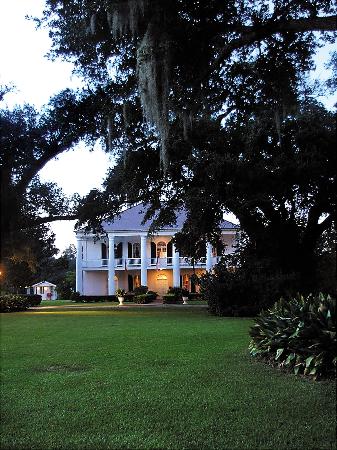 In 1776 a Spanish land grant awarded Pierre Declouet a rise of ground about eight miles from what is now the city of Opelousas. Hippolyte Chretien, one of three brothers from France, purchased the property in about 1800 to raise cotton, the popular crop of the area.
In 1776 a Spanish land grant awarded Pierre Declouet a rise of ground about eight miles from what is now the city of Opelousas. Hippolyte Chretien, one of three brothers from France, purchased the property in about 1800 to raise cotton, the popular crop of the area.
Stories mention the friendship that Hippolyte had a with the brothers Jean and Pierre Lafitte, who used Chretien Point to conceal and move some of their smuggled cargo – and slaves. These tales are credible because Chretien accumulated hundreds of slaves to work his ever increasing cotton-producing acreage in a seemingly short time.
In 1812 during the Battle of New Orleans, Hippolyte Chretien and some of his neighboring planters joined the pirates Lafitte and General Andrew Jackson in this fight, which defeated the British. One of the gentlemen that fought with Chretien was a man known only as Senor Neda. Neda’s daughter Felicite married Hippolyte Chretien II and became one of Louisiana’s first “liberated” , women. Behaving very unconventionally for her time, Felicite was active in the management of plantation business, smoked cigarettes, and even was adept at card gambling. Felicite increased the plantation holdings by whatever methods she could. She acquired much property because of her proficiency at cards as well as her dealings with New Orleans bankers and businessmen, almost unheard-of activities for a woman at that time. Her courage and self-sufficiency were more than helpful because her husband and one of her two sons died from yellow fever shortly after the house was completed. She unearthed his money, which was buried on the grounds, after convincing Hippolyte’s faithful servant, Pajo, to reveal its hidden location.
This remarkable lady also possessed physical courage: It seems she herself thwarted a robbery attempt by shooting a thief in the head and frightening off his accomplices by confronting them with the possibility of a similar fate.
During the Civil War, a battle fought on the plantation grounds was led by Federal general Nathaniel Banks and Confederate general Alfred Mouton. Hippolyte Chretien III, though sick and feeble, saved the house by giving a secret Masonic sign that was honored by General Banks, a fellow Mason. Though the house was spared, the rest of the plantation buildings were destroyed by Yankee forces.
Hippolyte III inherited the plantation and lived at Chretien Point with his wife, Celestine Cantrell, and their son Jules. Jules was a multitalented young man, and unfortunately the family was more interested in the creation and appreciation of the arts and not in the practical science of management. After several crop failures the family attempted rice production, which also failed. The property was eventually lost to the mortgage holders. Jules became a traveling salesman of kitchen utensils.
The house was restored to its original magnificence in the late 1970s. The six-brick Tuscan pillars at front are based on square foundations that anchor the wide, wooden, balustrades gallery; the pillars rise two stories to the eaves of the hipped roof. Round-headed French doors and windows are features in each room. Chretien
Point’s great room is graced with unique mantles of verde-antique Italian marble with Ionic capitals and shelves of black onyx. Ceiling medallions are elaborately a carved. Exterior walls are eighteen inches thick and the house measures sixty-three feet wide by forty-seven feet deep.
Sadly, the original furnishings were destroyed by fire after they were moved to a small hotel, which was operated by one of the Chretien heirs. The present owners, the Cornay family, have again beautifully furnished the house and graciously opened it to plantation tours.
For more information on tours visit the Hotel Monteleone’s attraction listing of the Chretien Point Plantation.
